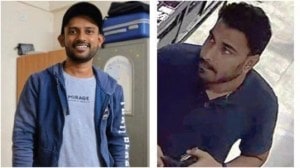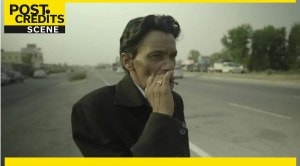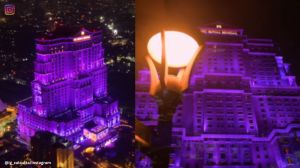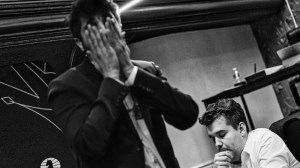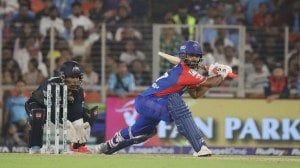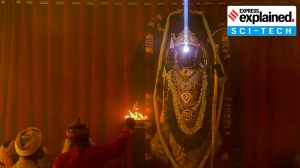- India
- International
Gone off the rails: How and why the Mumbai Monorail project flopped
The Monorail was hailed as the panacea for Mumbai’s transportation woes. Shoddy planning has turned the project into a white elephant. The Indian Express finds out how and why it has flopped.
 The Monorail line, which took a decade to come up at a cost of Rs 2,700 crore, serves only 7,000 travellers daily as of July. (File)
The Monorail line, which took a decade to come up at a cost of Rs 2,700 crore, serves only 7,000 travellers daily as of July. (File)
Marge Simpson, the blue-haired matriarch in the animated television series Simpsons, calls the Monorail as the only folly the people of the fictional town of Springfield ever made.
Mumbai is no Springfield, but the 19.54-km long Sant Gadge Maharaj Chowk-Wadala-Chembur Monorail, whose monthly ridership has halved from 5.55 lakh in March to 2.13 lakh in July, stands as a testament of the follies that the city’s urban planners have made in designing Mumbai’s transportation systems.
Mumbai, in the next decade, will spend close to Rs 2.4 lakh crore in constructing Metro lines, sea bridges and coastal roads. Many believe that these transportation projects are independently undertaken by agencies without any understanding and vision. The absence of any public consultation while planning these projects means they end up not serving the people for whom there are designed for.
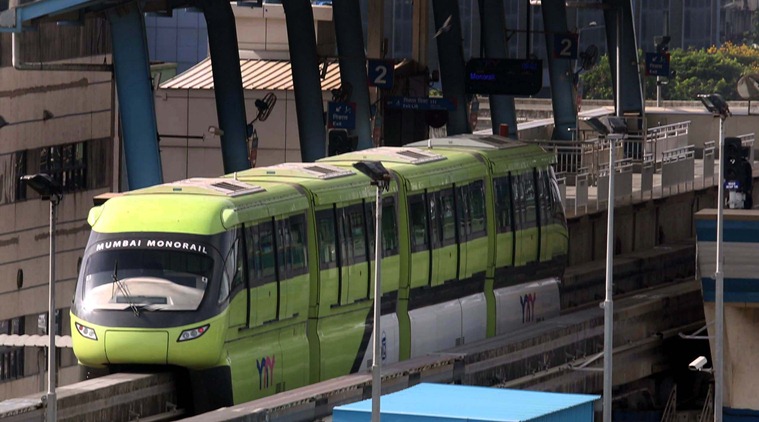 The idea behind Monorail was to create an alternate transport system, which would weave through some of the most dense and congested parts of Mumbai. (File)
The idea behind Monorail was to create an alternate transport system, which would weave through some of the most dense and congested parts of Mumbai. (File)
While the city’s suburban train system serves 78 lakh people every day, BEST caters to 25 lakh and the Metro 4 lakh daily. In contrast, the Monorail, which took a decade to come up at a cost of Rs 2,700 crore, serves only 7,000 travellers daily as of July.
At the Wadala depot station, which has more securitymen to guard the Monorail than passengers, commuters like 21-year-old Nitesh Shelke are paying a price for this folly. “I have heard that they have spent thousands of crores to build this service. But how can it be an efficient transport system if people have to wait 20 or 30 minutes to get a ride,” Shelke, a student, said.

Read | ‘Procurement of spare parts from foreign vendors takes time… affecting services’: D L N Murthy
The city’s burgeoning population and crumbling transportation network definitely cries out for new and efficient modes of transportation. In Mumbai, where traffic is perennially affected due to infrastructure construction, the Monorail was envisaged as a lightweight transport system. Planners believed that its manoeuvrability and nimbleness to navigate tight turns and narrow corridors would make it ideal for the urban congested corridors.
 In Mumbai, where traffic is perennially affected due to infrastructure construction, the Monorail was envisaged as a lightweight transport system. (File)
In Mumbai, where traffic is perennially affected due to infrastructure construction, the Monorail was envisaged as a lightweight transport system. (File)
“It is not a bad transportation system. However, there are serious questions on whether it suits Mumbai,” said Ashok Datar, chairman of Mumbai Environmental Social Network.
Mumbai’s erstwhile city planners failed to take into consideration the fact that the Monorail was increasingly being looked down upon as a transportation technology.
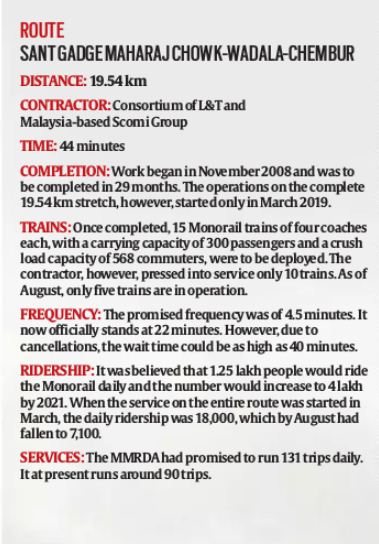
There are around 70-plus Monorail systems across the world. Only a handful like that in China, Japan and Malaysia are used as meaningful transportation systems. The rest are found at amusement parks, airports or convention centres to ferry vistors. The global Monorail market, as per research reports, is expected to grow at a rate of 2 per cent and no big country, barring Brazil and Egypt, is now planning a largescale Monorail system.
TRYST WITH METRO
The plan to construct a Monorail line across the city was first mooted in 2005 with the appointment of a committee of bureaucrats and experts to identify possible routes. The idea was to create an alternate transport system, which would weave through some of the most dense and congested parts of Mumbai.
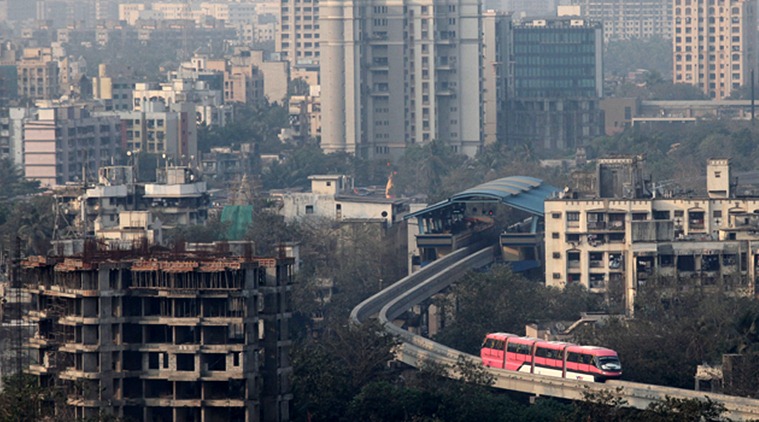 The decision to scrap future Monorail lines seemed to have been a major setback for Malaysia-based Scomi’s expansion plans in India. (File)
The decision to scrap future Monorail lines seemed to have been a major setback for Malaysia-based Scomi’s expansion plans in India. (File)
The committee identified Sant Gadge Maharaj Chowk-Chembur-Wadala Road corridor as the route on which the first Monorail line should be built. The plan, which had then looked sound, envisaged connecting the mill belt of Byculla-Parel that house many corporate offices to then sparsely-populated pockets of Wadala-Chembur belt.
There were allegations that the project was being pushed largely for the benefit of big-pocketed builders with stakes in the Wadala-Chembur stretch, as having a green field transport system abutting their buildings would add a premium to real estate projects in the vicinity. The Wadala-Chembur belt today is one of the costliest real estate destinations in Mumbai.
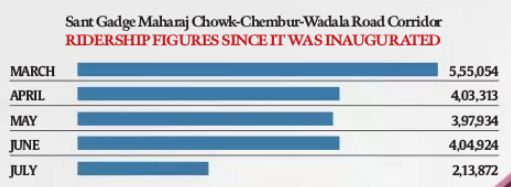
In one of the fastest turnaround time for an infrastructure project in Mumbai, the tender for Sant Gadge Maharaj Chowk-Chembur-Wadala Road corridor was floated in November 2007. In less than a year, the state Cabinet approved the awarding of the tender to a consortium of L&T and Scomi Group. The project, which was initially expected to cost Rs 1,440 crore, was finally awarded at a cost of Rs 2,450 crore and was to be completed in 29 months.
So smitten were the state’s bureaucrats with the project that several trips were undertaken to Malaysia to inspect the Monorail service there.
The Monorail was deemed to be the panacea for Mumbai’s travel woes. The Mumbai Metropolitan Region Development Authority (MMRDA) subsequently appointed a foreign consultant, Lea Associates, to come up with a master plan for building other Monorail corridors in the city. The consultancy submitted a master plan and the state allowed the approval for building an eight-line Monorail system at a cost of Rs 20,296 crore. It was to be completed by 2021.
THE DREAM UNRAVELLED
Work on the project began in November 2008 and was expected to be completed in 29 months. The Wadala-Chembur stretch was expected to be completed by December 2010 while the Sant Gadge Maharaj Chowk-Chembur route was to be finalised by May 2011. Once functional, it was expected that 1.25 lakh people would use the services daily. MMRDA officials had claimed that the Monorail would help reduce nearly 28,000 taxi and rickshaw trips and help in taking off the nearly 25,000 cars that traveled on this stretch.
However, once work commenced, the officials realised that the project had been poorly planned. The contractors were forced to undertake changes and alter the route after they realised that the Monorail could not pass through congested and narrow lanes, especially near Parel Tank Road.
The state home department also put a spanner in the works after it came to notice that the Monorail would pass close to the Arthur Road Jail, which was then housing high-value prisoners, including the likes of Ajmal Kasab. Officials had felt that the running Monorail and its guideway could provide access to people to look inside the jail and could be used by persons with nefarious intentions. The permission to build on the stretch was given after the MMRDA promised to install view cutters to keep peeping toms away from getting a view of inside the jail. MMRDA was also asked to construct two watchtowers near the jail.
Further, the contractors also faced massive difficulties in building the Monorail over the Lalbaug flyover, located on Mumbai’s arterial road. The work on the congested Currey Road stretch was also extremely time consuming.
With the project getting stalled, it was the change of guard at the MMRDA that led to the scrapping of the Monorail plans for Mumbai. Rahul Asthana, who took over as MMRDA commissioner in 2011, decided to review the entire project.
“When we did a cost benefit analysis for a Monorail, we realised that its carrying capacity was nearly a third of the Metro. Moreover, the cash contract model that we had used for the project was not sustainable, as we had to shell out upfront money to contractors. This money could have been used judiciously for more important projects,” a former MMRDA official said.
With the existing project yet to reach completion, the MMRDA decided to pull the plug on all the proposed Monorail lines in the city.
WHAT WENT WRONG
After five-and-a-half years in the making, the Monorail commenced operations on a 8.8-km stretch between Wadala and Chembur. Of the total 15 trains that Scomi had promised, only 10 were deployed on the stretch. Because of the awkward alignment of the stretch, which snaked through largely vacant parts of Mumbai, the ridership was only 15,000 to 20,000 per day — much lesser than the anticipated 1.25 lakh. Many of these riders were not daily commuters but people who wanted to experience a ride on Mumbai’s latest ‘toy train’.
The decision to scrap future Monorail lines seemed to have been a major setback for Malaysia-based Scomi’s expansion plans in India. A global downturn in the company’s fortunes, coupled with its conflict with the MMRDA for financial matters, including cost escalations, saw a severe deterioration in Monorail services that were frequently disrupted due to power outages and technical glitches.
In November 2017, two coaches of the Monorail were completely gutted. Services subsequently resumed in September 2018.
Even as the two sides were embroiled in an arbitration with the contractors claiming about Rs 1,000 crore in cost escalation above the project cost of Rs 2,700 crore, a frustrated MMRDA in December 2018 decided to take over the maintenance and operations of the system.
In March 2019, it started operations on the complete 19.54-km Sant Gadge Maharaj Chowk-Chembur-Wadala Road stretch. Chief Minister Devendra Fadnavis, while inaugurating the service, said the Monorail would no longer remain a joy ride but would offer last mile connectivity to the people. He claimed that the ridership would increase from 4.5 lakh to 30 lakh annually.
However, the system leaves a lot to be desired. There are only four trains that operate on the system. The official frequency of trains is said to be one every 22 minutes. In reality, however, a passenger may have to wait for up to 45 minutes.
“Why should people wait for 30 minutes to get a ride in a city like Mumbai where every minute is precious? People who are in a rush, cannot rely on the Monorail. It is only meant for people who want to travel at leisure. That is a luxury that not many people in Mumbai have,” said Pramod Sawant, an HR professional who works in Parel.
Best of Express
Apr 18: Latest News
- 01
- 02
- 03
- 04
- 05















